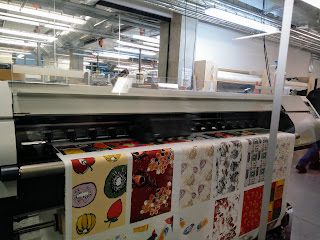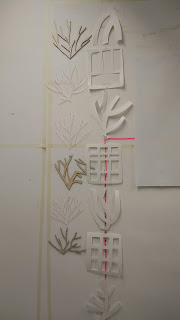Arts and Crafts Houses
For my third year essay, I
am planning to focus on the Arts and Crafts movement, especially William Morris and his influence on it. I want to focus on his desire to embrace traditional craft
practices in protest against the increasing use of machinery in design,
considering how this is being echoed in the technological age we are experiencing
today.
In order to broaden my
understanding of the arts and crafts period, I have visited several significant
properties from this period during the summer break.
First, I visited Red House
in Bexley Heath. This was the only house ever built by William Morris, and when
visiting, you get a sense that this was designed to be an oasis and hive of
creative life. Now it is situated amongst many other houses on the outskirts of
London, but when it was built Red House sat in open country.
The house was designed by
Phillip Webb, with whom Morris collaborated on sketches for the house and
supervised its construction. The building took a year, finishing in the
early 1860s, and the house is L-shaped with two wings which meet in the
hallway. It was decorating and furnishing Red House which inspired Morris to
found the interior design firm Morris & Co.
Although the interior of
the property has changed greatly in the years since Morris and his family
lived there, I found it easy to imagine what it could have been like to live
and work there, enjoying the generous layout and the extensive gardens, in which
were planted flowers which inspired many of Morris’ wallpaper designs.
 |
| An example of Morris' wallpaper at Red House. |
When Morris and his family
were living there, there would have been abstract murals adoring many of the
walls and ceilings. Some of which can still be seen such as the one above the
main stair case, which highlight the eclectic taste and enthusiasm for
decoration of the owner.
Morris was a generous host
and enjoyed having many weekend visitors at the house. Despite dreams to move
Morris & Co. out of London to Bexley heath, ill health forced Morris to
abandon Red House in 1865, along with his dream of establishing a community of
artists who lived and worked together there, however these ideals remained
central to the ethos of the Arts and Crafts movement.
What I loved most about Red
House was the garden which surrounded the house. Full of plants, I could
imagine spending hours exploring and enjoying watching the seasons change which
would provide endless artistic inspiration. I also really enjoyed seeing the
quirky remnants of the original owners, such as the painted staircase ceiling
and stained-glass windows which provide a glimpse into the chaotic but inspiring
experience it must have been to live there during the Morris family’s tenure.
 |
| Stained glass windows. |
I also visited Kelmscott
Manor in Oxfordshire, the Morris’ country retreat. Morris and his family first
began visiting Kelmscott in 1871 and continued to visit the property until his
death in 1896, his daughter May later returning to the house permanently.
Although modest in terms
of Manors and country homes, Kelmscott is still an impressive property, set in
Kelmscott village with extensive grounds, which, like at Red House were full of
flowers to inspire his designs.
 |
| Kelmscott Manor from outside. |
In the same way that
Morris hoped Red House would be a place for artists to convene and work
together, he dreamed of Kelmscott becoming a utopia for artists, men and women
alike. It was here that he established much of his seminal thinking on topics
such as interior design, industry, craft work and building conservation.
I found Kelmscott manor to
be a really interesting home, architecturally, and I particularly enjoyed
seeing the attic where small rooms are tucked away under the eaves, slowly revealing
the extent of the building’s nooks and crannies.
It was also fascinating to
see Jane and William Morris’ bedrooms, both decorated with linen embroidered by Jane and May Morris. I think
the thing which stood out to me most was the meticulous detail which went into
decorating and furnishing the homes of the Morris family. Morris himself was
committed to a life engrossed in arts and crafts and this is evident throughout
the places where he lived. Despite his dreams of establishing a creative community in the coutnry coming to fruition, it is clear that he invested immense energy into
surrounding his family with the best examples of craft and design from the
period.
 |
| William Morris' bed covered with intricaltely detailed embroidery. |
 |
| Morris & Co. fabric covering furniture at Kelmscott. |
Finally, I visited
Blackwell, an Arts and Crafts house overlooking Lake Windermere in the Lake District.
Built by architect Mackay Hugh Baillie Scott as a holiday home for his client
Sir Edward Holt, the house, completed in 1901 is an excellent example of the
Art and Craft style. Baillie Scott was
one of the most influential architects of the early 20th century and
Blackwell is his most important remaining house.
 |
| Floral tapestry in the dining room. |
 |
| The Main Hall at Blackwell. |
Throughout the house are
examples of Arts and Crafts details including furniture designed by William
Morris and tiles surrounding the fireplaces by William de Morgan. Placing great
importance on south facing rooms and windows to benefit from the sun, the house
has large open plan living spaces, unlike most Victorian architecture which
tended to favour more compact, complex layouts. Scott used light creatively to
control the atmosphere in each room.
 |
| One of the bright, light-filled bedrooms at Blackwell. |
What I liked most about Blackwell was the way it payed homage to many different Arts and Crafts styles, incorporating variety of crafts from ceramics, to wood carving, to textile hangings and furniture. I also admire the way Baillie Scott was involved with all aspects of the design and furnishing of the property, viewing it as a holistic process.
Visiting these houses has
given me an in-depth understanding of the Arts and Crafts movement, as well as
a much greater appreciation of the work and ideals of William Morris. I feel
that having been able to experience the places where he lived and worked, I am
better able to picture the reasons for the popularity of the movement and
analyse its success and failings in relation to modern attitudes towards traditional
crafts.






Comments
Post a Comment